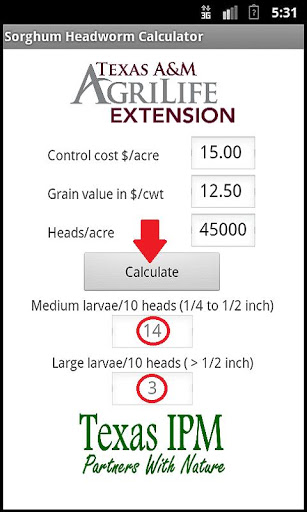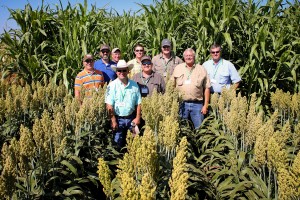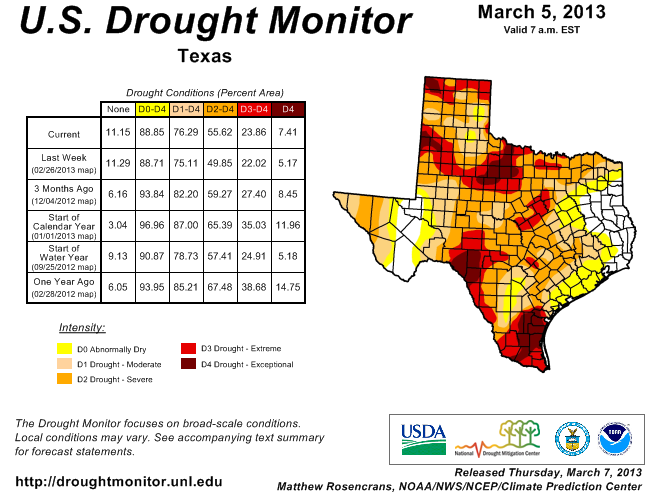- About UsTexas Grain Sorghum Association is….
- Texas Sorghum InsiderNewsletters…
- Legislative News
- Photos
- Contact UsTexas Grain Sorghum Association P.O. Box 905 Salado, TX 76571 Wayne Cleveland, Executive Director wcleveland@mindspring.com (254) 541.5375 Morgan Newsom, Producer Relations Coordinator morgan@texassorghum.org (806) 438.5994 SEND US A MESSAGE: [contact-form-7 404 "Not Found"]
- Sorghum Dashboard
- Events
September 11, 2013
TGSP Board Members Tour Seed Industry – Last week, several members from the TGSB and TGSA Board of Director’s toured the seed industry in the High Plains to learn more about advancements and research happening in the sorghum industry. The two-day event began with a tour of the Richardson Seed facility in Vega, Texas, where they viewed seed production, bagging and treatment. The group then traveled to NexSteppe in Hereford to view biomass sorghum production, and then continued onto Advanta to look at their grain and forage research plots. The first day came to an end in Plainview at Pioneer where they toured their retail nursery, research plots and seed processing plant. The next day the group began at USDA-ARS in Lubbock to view their advancements and finally ended the day at Chromatin’s Idalou nursery to view their research plots. Pictured above are the Texas members at Chromatin who attended the seed tour. (L-R: Jason Frantz, Texas Farms & TGSA board member; Wayne Cleveland, TGSP Executive Director; Greg Good, Texas Farms; Charles Ray Huddleston, grower and TGSA board member; Jim Massey IV, grower and TGSA & TGSB board member; Chuck McDonald, grower and TGSB Chairman; Blake Tregellas, grower and TGSB board member; Daniel Krienke, grower and TGSA board member; and James Born, grower and TGSB Vice-Chairman. USCP has provided more photos from the seed tour, just search #USCPSeedTour on Facebook, Twitter and Instagram to view them.
HPWD Names New General Manager – The High Plains Underground Water Conservation District (HPWD) announces Jason Coleman as their new general manager. Coleman served as general manager of the South Plains Underground Water Conservation District in Brownfield since 2000, where his district covered 1,200 acres in Hockley and all of Terry County. He grew up on a cotton farm new Meadow, Texas and is a registered Professional Engineer in Texas. Coleman takes over the position of Jim Conkwright who retired from the position on June 30th. Brad Heffington of Littlefield and a current HPWD Board Member said, “Jason shares our West Texas values. He understands that the High Plains Water District is here to protect landowners’ rights-while at the same time-developing policy to help landowners conserve groundwater and use it as efficiently as possible for generations to come.”
On The Hill – The House and Senate are back in session after the August recess and the Southwest Council for Agribusiness (SWCA) has provided a glimpse into what is expected to happen on the hill this month. They suspect the debate over Syria to stall other issues. The issue is expected to scramble the legislative calendars and could stall the consideration of the SNAP vote expected to occur the first week of this session. With the House expected to cut $40 billion from the SNAP program, the new annual report on food insecurity showed 14.5% of American households were listed as “food insecure”, and this is sure to come up in the debate. Also on the hill, the U.S. is expected to reach their borrowing limit by mid-October and President Obama said he will not negotiate over raising the debt ceiling as he did in 2011. This year, sugar prices are down and USDA announced that approximately 85,000 tons of sugar that was pledged as collateral for the marketing loan program as forested to the government. This has caused the sugar price to drop approximately 50% in one year leaving many producers with the only option but to forfeit their crop. Finally, EPA announced that 16.55 billion gallons of renewable fuels must be blended into the U.S. fuel supply in 2013,which calculates to a 9.74% blend. Specifically, 1.28 billion gallons of biomass-based diesel, 2.75 billion gallons of advanced biofuels (sorghum qualifies), and 6 million gallons of cellulosic biofuels are required this year.
NSP Announces Upcoming Contests
Yield & Management Contest – Winners will be recognized at the annual Commodity Classic held in San Antonio, Texas of February 2014. Entry forms must be filled out completely and postmarked at least 30 days before harvest for “Regular Entry” or at least 10 days before harvest for “Express Entry” of the contest field. Please click here for more information and to download the entry form.
Super Sorghum – You can win a “#SuperSorghum” t-shirt by using Facebook, Twitter or Instagram to post or tweet using the hashtag “#supersorghum” and let them know how your crop is doing this season. The more you use the hashtag, the greater your chances are to win. NSP will pick a winner at the end of the months of September, October and November.
Sorghum Grower Kids Cover Contest – Your farm kids could be on the cover of the Sorghum Grower magazine. During this growing season, photograph your kids as they participate in sorghum farming activities. The winning phograph will appear on the winter 2014 issue. Photographs receiving second and third place will receive honorable mention on NSP’s website. For more information, click here.
August 13, 2013
2013 Master Marketer Course – Registration is now open for the 2013 Texas A&M AgriLife Extension’s Master Marketing Program. The course will begin on September 17th and will be held in El Campo, TX this year. The course consists of 64 hours of intensive marketing and risk management education for opportunities enabling Texas producers the possibility to improve their bottom line. Sessions are taught at a highly applied level while combining creative teaching and learning concepts to get successful results. Sessions are taught by some of the best speakers concerning topics involving weather, crop insurance strategies, financial management, futures markets, technical analysis, marketing plans, legal issues, and grain, cotton, and livestock fundamentals. Pre-registration is required by September 10 and is available online at https://agriliferegister/tamu.edu/AgEco or by phone at (979) 845-2604. The cost of the program is $340. Texas Grain Sorghum Producers are sponsors of this exceptional program and encourage sorghum producers to attend. If you are a sorghum farmer interested in a scholarship provided by TGSB to cover registration, please contact Wayne Cleveland at wcleveland@mindspring.com.
TAFA Young Farmer Grant Program – The Texas Agricultural Finance Authority (TAFA) Young Farmer Grant is now open to receive applications. The TAFA Board has announced the availability of $150,000 in Young Farmer Grants to expand or enhance agricultural production in Texas. The grants, ranging from $5,000 to $10,000, are available to agricultural producers at least 18 but less than 46 years old. Original, signed applications must be received in the offices of the TDA by 5:00 pm, September 6th. For more information, click here.
Krienke Named to Regional Water Planning Group – Members of the Panhandle Regional Water Planning Group (RWPG) selected Danny Krienke as a member of Planning Group A at their most recent meeting in July. The legislature created the RWPG in 1997, to develop water supplies and prepare plans to meet the state’s future water needs. The Groundwater Management Area (GMA) Joint Planning Committee selected Krienke for this position because of his familiarity with the joint planning process and his demonstrated ability to represent all of the GMA. There are 16 planning groups made up of about 20 members. The planning groups allow for public involvement in direct planning and determine which water management strategies to recommend. Krienke farms in Ochiltree County and is past-president of Texas Grain Sorghum Association.
Annie’s Project – A women’s workshop series, Annie’s Project, is coming to Amarillo every Tuesday from 6-9 p.m. beginning on September 17 and running through October 30, 2013. The focus of this series, according to Texas A&M AgriLife Extension service specialist, is getting a grip on today’s agriculture business and becoming an effective farm partners and decision-maker. The mission of Annie’s Project is to empower farm women to be better business partners through networks and by managing and organizing critical information. The cost is $50/person and the class size is limited to 30. Registration slots will be filled on a first-come, first-serve basis. The registration form is available online at http://bit.ly/12HTxJ4. According to the 2007 Census of Agriculture, there was a 30 percent increase in the number of farms principally operated by women since 2002. Participants will receive training in critical decision-making and information areas addressing: production risk management, marketing risk management, financial risk management, estate planning resources, legal risk management and human resources risk management.
July 25, 2013
Japanese Trade Team in Texas – This week, Texas Grain Sorghum Producers, the Sorghum Checkoff and the U.S. Grains Council hosted a team of nutritionists and merchandisers from Japan. The team began Monday north of Austin where they toured Mr. James Karmas farm (top right), then traveled to the DFW area and visited Frank Bailey Grain (top left). Tuesday the group visited TGSP Board Member, Charles Ray Huddleston’s, operation in Celina then attended a nutritional seminar on beef and dairy. Wednesday the group headed to the High Plains area where they stopped by Attebury Grain’s main office (bottom left), headed up to Etter to tour Gavilon Grain and Dimmitt Flaking (bottom right) and then toured a beef feedlot at Qualify Beef Producers in Wildorado to learn about feeding sorghum silage and flaked sorghum. Finally, the group was invited into the home of TGSP Board Member, Troy Skarke, in Claude to have a steak dinner and visit with farmers and friends (center). The group is in Kansas the rest of this week to continue to learn about U.S. sorghum production, nutritional values and quality.
SICNA Registration Open – The annual Sorghum Improvement Conference of North America (SICNA) will be held in Lubbock, Texas, Aug. 28-30, 2013. SICNA focuses on promoting communication in the areas of research and development relating to improvement of sorghum as a crop. Those interested in attending the SICNA meeting may find registration information and a preliminary agenda at sicna.net.
Ogallala Aquifer Initiative Used to Help Farmers in Drought – Four years ago, in response to declining water levels of the Ogallala Aquifer, the Natural Resources Conservation Service (NRCS) in Texas launched the Ogallala Aquifer Initiative (OAI) program in an effort to assist producers in addressing water quantity and quality concerns. The OAI has helped landowners improve irrigation systems and enhance the economic viability of cropland located above the aquifer. It also offers opportunities to convert to non-irrigated production. Currently, over 151,000 acres are enrolled for more than $23 million. The OAI is administered through EQIP. For more information, contact your local USDA Service Center office or visit www.tx.nrcs.usda.gov.
CRP General Sign-Up Results – Agriculture Secretary Tom Vilsack announced the USDA is accepting 1.7 million acres under the 45th Conservation Reserve Program (CRP) general sign-up. The department received nearly 28,000 offers on more than 1.9 million acres of land. Since 2009, USDA enrolled nearly 12 million acres in new CRP contracts, and there are currently more than 26.9 million acres enrolled on 700,000 contracts. As of June 2013, Texas had 21,152 contracts, for a total of 15,440 farmers on about 3.3 million acres of land. The annual rental for Texas is $121,309,000 and shows a $37.19 payment/acre. For a state-by-state breakdown of coverage and for more information, click here.
July 9, 2013
Colombians & Japanese Tour Texas Sorghum – At the end of June, an international group from the large Japanese company, Zen Noh; and two participants from the largest feed milling company in Colombia, ITALCOL, toured various parts of the Texas sorghum industry. These groups made stops at sorghum farms, elevators and ports across southern and central Texas. Texas Grain Sorghum Producers, the US Grains Council and the Sorghum Checkoff sponsor international groups during the year to better educate them on the value and quality of Texas sorghum. It is important for these companies to see our product up close and visit with potential sellers of grain sorghum, so that Texas sorghum can be sold consistently and at a competitive price across the world. Another group from Japan will be coming to Texas at the end of July that will be represented by four large companies who want to learn more about our sorghum. Japan is currently the second largest importer of U.S. sorghum.
Proposal to Split Farm Bill Divides Congress – The National Journal reported there is tension between Republican Groups as the House Republican leadership tries to salvage the failed farm bill from last month. House Speaker John Boehner’s (R-Ohio) leadership is getting tested by House Majority Leader Eric Cantor (R-Virginia). Cantor and other groups are portraying Boehner as a weak leader and are trying to make the more conservative Cantor the speaker. It is now stirring up tension as to whether House members have become more responsive to national conservative groups than to farmers and anti hunger advocates in their own districts. Cantor voted for the Farm Bill on June 20, but since its defeat has been promoting the idea of splitting the bill in two, which would separate votes on the nutrition and farm programs. Ag Chairman Frank Lucas (R-Oklahoma) on the other hand, stands by his bill and said that conservatives were turning their back on the bill’s $40 billion in savings over 10 years, including a $20 billion cut in food stamps. Congress will return on Monday and Boehner returns with a coalition letter of 532 farm groups “urging him to bring the bill back to the floor and move a unified farm bill forward.”
June 19, 2013
Contact Your Congressman’s Office ASAP – With uncertainty looming without a Farm Bill passed this year, it is now time to take action. The Senate recently passed their version of the Farm Bill and now it is time to get it through the House so that farmers know what to expect from the government in the next five years. Many amendments were filed to the House Farm Bill and now agricultural groups are asking for your help to vote FOR the Farm Bill and AGAINST all amendments to the Commodity Title and Crop Insurance. Debates on the amendments started at 11:00 am EST today and will go through 3:00 pm EST tomorrow. Email your representative’s Ag LA and call and leave a message with your congressman’s office. Use this website link to find information on how to contact your local congressman.
Concern for Sorghum Midge in the Coast & Valley – The National Sorghum Producers (NSP) recently put out a document to help growers in the Coast and the Rio Grande Valley with sorghum midge problems. The article describes the pest as a fragile looking, reddish orange fly about one-eighth to one-sixteenth inches long, smaller than a fruit fly. Each midge has the ability to lay 50 eggs and does a remarkable job of spreading them around to fifty different sorghum flowers during her one-day life. The eggs hatch in two-three days with larvae developing and feeding on the kernel. The emerging adult fly leaves behind the clear or white pupal skin. If you see this cocoon like remains at the tip of the spikelet then damage has already been done resulting in no or shriveled grain. To monitor and control this pest, appropriate inspection is required. Field checks must be made beginning shortly after blooming begins. Inspect field borders first, particularly those downwind of earlier flowering sorghum or johnsongrass. Monitor from mid-morning to early afternoon and at a low wind time. Currently, one midge per head suggests value for spraying the insect – later season planting is generally more vulnerable. If adults are found 3 to 5 days after the first application fof insecticide, immediately apply a second insecticide treatment. Choice of insecticide can be best determined by the ag supplier or aerial applicator. For more information, contact your local crop consultant or A&M AgriLife Extension Agent.
Sorghum Seeding Rates Video on YouTube – The Sorghum Checkoff has released a YouTube video about how to determine the seeding rate that is best for your crop. It is important to consider the appropriate seeding rates to achieve high yields. Seeding rate largely depends on your region of production and moisture condition, both at planting and in season. To view this information video, brought to you by the SorghumCheckoff, click here.
Sorghum Checkoff Seeking Proposals – The Sorghum Checkoff is soliciting proposals for targeted research and education, with the goal to “Further Enhance the Opportunities for Sorghum Producers through Specific Projects and/or Education that will Increase Productivity and/or Demand.” For more information on each specific proposal in the categories of “crop improvement”, “high value markets”, and “renewables” please contact the Sorghum Checkoff. Proposals are due Monday, August 5, 2013 by 8:00 a.m. CST and can be submitted to proposals@sorghumcheckoff.com.
June 6, 2013
South Plains Finally Gets Moisture – The South Plains of Texas received some much needed rain on June 5. It was the first time you could see water standing in fields in quite some time. While some areas saw just a few tenths, other areas received up to 1.5 inches. The moisture should help boost the crops as planting is nearing an end; however, once you start digging it is not far until the moisture dissipates, especially on the dryland crops. This should help give a small boost to the irrigated fields, but dryland crops will still need added moisture to sustain a crop. The area has seen a bump in irrigated sorghum acres this year as compared to previous years, but several growers still decided to turn to cotton once the price started going up a few months back. West Texas wind plays a large role in the weather pattern too, especially in the plains, as the winds got up to over 80 mph with the storm and will probably make their way back into the west fairly soon. The sorghum fields that are already up look promising thus far. Even with the recent rains, ninety-seven percent of the state still remains in exceptional to extreme drought, as compared to ninety-one percent last year. Continue to pray for rain for the state!
Senate Farm Bill Inching to an End – With the Senate planning to have their cloture vote on the Farm Bill on Monday, the Republicans are going to have to step up their game. Plains Cotton Growers (PCG) reported there are many split decisions especially with net farm income in the Midwest showing increases much faster than the national average and income for the Southeast and Southern Plains trailing behind or even declining. The Senate bill is currently leaning towards devoting $23.7 billion over 10 years to a new Agricultural Risk Coverage program, favorable to corn, but to alleviate the South, Chairwoman Stabennow has added a $3.4 billion adverse market countercyclical program including target prices for rice and peanuts. The wait continues. As for the House, they are still expected to take up the bill on the floor in mid-June.
Trade with Colombia Getting Closer – The U.S. Grains Council (USGC) has been diligently working for the past 15 years educating the Colombia trade market on how to efficiently move grain from the U.S. into their country. One example, is last month, the Council sponsored Mike Toohey, president of the Water Way Council, to be the keynote speaker at the Colombian Business Chamber’s 4th Annual Forum on Bulk Transportation. The goal of the conference is for Colombian feed grain importers and government officials to find long term solutions to upgrade Colombia’s bulk gain transportation system and benefit Colombian customers. He addressed to the Colombians that modernization is the key to success. Colombia struggles from significant transportation systems such as poorly maintained roads, under-developed river systems and a limited railroad infrastructure; however, they are the only South American country with ports on both the Atlantic and Pacific oceans giving them ideal means to make trades with the U.S. Once Colombia can improve their in-country transportation issues, the rest should readily fall into place. The USGC, the Sorghum Checkoff and the Texas Grain Sorghum Producers are hosting one of the top potential buyers of grain in Colombia, ITALCO, at the end of this month across Texas to showcase our quality of sorghum in hopes that future trades are in the near future.
May 14, 2013
Sorghum Checkoff Job Openings – The United Sorghum Checkoff Program (USCP) announced two available positions which are now open for application submissions. The first position is for a Regional Director – this job includes establishing, developing and maintaing end-user, first handler and producer relations within a geographic region. This position is also responsible for determining what can be done to develop, expand and promote sorghum. The second position is for a High Value Markets Program Director – this job includes determining what can be done to develop, expand and promote sorghum marketplaces both domestically and internationally. Resumes and cover letters for these Sorghum Checkoff positions will be accepted until June 15, 2013, and can be sent to positions@sorghumcheckoff.com. To view the complete announcements and summary, visit sorghum checkoff.com.
Valley Growers Plant Sorghum Over Cotton – With the drought, the deflated market prices, the price of cotton in the world market during spring planting and China’s huge stockpile of cotton, many Valley farmers opted to plant sorghum over cotton this year. The Valley Morning Star reported the amount of cotton planted this year is less than last year, with 86,000 acres in the Lower Rio Grande Valley, down substantially from the 130,000 acres last year. Sorghum’s drought tolerance played an important role on the farmers decision as well, with the dry spell lingering on and uncertainty about access to irrigation water. After planting, the rain never fell and insurance adjusters are out in the fields assessing cotton crops – the expected failed cotton acres will probably be extremely high. Many farmers may try to go behind failed cotton with even more sorghum going into the Rio Grande Valley fields.
USDA Announces Farm Payments Scheduled to Resume – The U.S. Department of Agriculture’s Farm Service Agency (FSA) announced last week that farm payments, which had been temporarily suspended due to sequestration, were scheduled to resume May 8, 2013. This includes payments for the 2011 Supplemental Revenue Assistance Payments Program (SURE), the Noninsured Crop Assistance Program (NAP) and the Milk Income Loss Contact Program (MILC). The suspension began on March 4, 2013 in order for FSA to assess the impact of sequestration and determine the least-disruptive process possible for carrying out required cuts. Current enrollment deadlines for signing up this year are as follows: 2013 ACRE – June 3rd; 2011 SURE – June 7th; and the 2013 Direct and Counter-Cyclical Program – August 2nd.
Monsanto Wins Seed Case as High Court Backs Patent Rights – AgWeb reported that the U.S. Supreme Court bolstered Monsanto Co.’s ability to control the use of its genetically modified seeds, ruling that companies can block efforts to circumvent patents on self-replicating technologies. The justices unanimously upheld an $84,456 award Monsanto won in a lawsuit against Vernon Hugh Bowman, an Indiana farmer. Rather than buying herbicide-resistant soybean seeds from a Monsanto-authorized dealer, Bowman used harvested soybeans containing the technology to plant his crops. The case centered on a technology that has helped make Monsanto the world’s largest seed company, with $14.7 billion in annual revenue, as well as a prime target for opponents of genetically modified food. Monsanto has sued 146 U.S. farmers for saving Roundup Ready soybeans since 1997, winning all 11 cases that went to trial. Bowman sought to get around Monsanto’s rules from 1999 to 2007 by buying less expensive soybeans from a grain elevator. Because the elevator accepted harvests from farmers using Monsanto seeds, the second-generation beans proved to be herbicide resistant. The farmer says he saved $30,000 for his farm. For more details on the case, look up Bowman v. Monsanto 11-796.
April 25, 2013
NSP BOD Nominations – The National Sorghum Producers (NSP) nominating committee is currently seeking applications to fill four seats on its board of directors. Nominated directors will serve three-year terms that begin on Oct. 1. NSP’s mission is to improve the sorghum industry through advocacy and leadership, and their vision is to lead legislative and regulatory change through effective policy and relationships for a more profitable, diverse and competitive sorghum industry. The deadline to apply for the board of director positions are May 1, 2013. Anyone wishing to seek more information about these positions, or to download an application, visit their website.
High Plains Freeze Injury Tool – Texas A&M AgriLife Extension recently had reports of freeze damage in Lubbock Co. for sorghum (that began to emerge on Monday) as well as some other freeze damage on corn in the High Plains. AgriLife has a document online, “Assessing Hail and Freeze Injury to Field Corn and Sorghum B-6014”, you can download and/or print to assess your freeze damage on your crop. Click here to access the website where the document is located and type ‘hail’ in the search box. For example, you can assess the % adjustment in yield potential with leaf loss at certain growth stages.
Senate Crop Insurance Fight Ahead – With consideration of another Senate farm bill in the near future, Senate Agriculture Committee majority staff members are discussing ways to avoid harmful amendments during the floor process, including a possible strategy of adding to the base bill two amendments approved during last year’s floor debate. The concept is to include the previously-approved amendments – which would tie conservation compliance requirements to crop insurance and reduce premium subsidies to farmers with adjusted gross incomes of more than $750,000 – with some modifications to make each more “farmer friendly.”
April 9, 2013
Young Farmer Grants – The Texas Agricultural Finance Authority (TAFA) Board has announced they have $150,000 available in Young Farmer Grants to expand or enhance agricultural production in Texas. The grants are available to agricultural producers at least 18 but less than 46 years old. An original, signed application must be received in the offices of the Texas Department of Agriculture by 5:00 p.m., Friday, May 3. No electronic, incomplete or late applications will be considered. The grants received under this program may be used to provide operating expenses such as seed, fertilizer and fuel. Funds can also be used to purchase livestock, feed, and associated costs which may include lease of land and any other operating oats associated with agriculture operation. Capital purchases that exceed $5,000 will not be eligible. Complete program information and the application is available by visiting the Young Farmer Grants website. The TAFA Board will review the applications and the grants will be awarded at their next board meeting in July. At their last board meeting, the board awarded 16 Young Farmer Grants.
2013 USDA Sorghum Predictions – The recent report from USDA (March 2013) predicts sorghum planted acres across the nation to be up from 6.244 million in 2012 to 7.620 million acres in 2013. USDA also predicted Texas sorghum acres to be up from 2.3 million in 2012 to 3 million in 2013. If the predictions ring true, Texas will become the number one sorghum producing state in the nation, surpassing Kansas with an estimated 2.9 million acres; however, if the drought keeps lingering actual production numbers will be a lot lower. The state with the largest increase in acres is predicted to be Missouri with a jump from 65,000 acres to 110,000 acres. The only states showing a decrease in acreage from 2012 are Arizona, Mississippi ,and South Dakota. Corn acres across the nation are expected to stay about the same at 97.28 million acres, with a slight jump in Texas from 1.85 million to 2.1 million acres. Wheat is close to 2012 at 56.44 million acres, and is expected to have the same amount of acres in the state this year. Upland cotton is projected to go down from 12.077 million acres in 2012 to a staggering 9.82 million in 2013. This is a large decrease from the previous years. Texas is expected to plant a million less acres of upland cotton in 2013, than the previous year.
U.S. Sorghum Exports Have Large Competitor in South America – Agrimoney released a report that due to the high international prices of corn, Mexico has shifted to using sorghum in their feed rations. While Mexico is finding alternatives to corn, this will reduce Mexican corn imports this season to a seven-year low of 7.70m tonnes – 800,00 tonnes below the USDA’s official estimate. Although corn imports are decreasing, sorghum imports will reach 2.50m tonnes this season – 700,000 tonnes above the USDA estimate. It is projected this number will increase in 2013-14 to an 11-year high of 3.05 m tonnes. Although sorghum is being imported, it isn’t all coming from the U.S. Much of the sorghum imported into Mexico is coming from South America, mostly from Argentina due to more affordable prices. Mexico began searching for alternatives after last year’s Midwest drought troubled the U.S. surplus of grain amounts. Mexico has been the nation’s top sorghum buyer for many years. Mexico has begun to do risk analysis on buying grains from Argentina. TGSP will continue to promote and educate Mexico’s buyers that our sorghum crop is a quality alternative to other crops and countries.
Vela Blasting Agencies About Water Owed from Mexico – Freshmen U.S. House Representative Filemon Vela, of the 34th District in Texas, is battling the U.S. State Department on water owed to the U.S. from Mexico. Vela told the Brownsville Herald “they don’t give a damn about South Texas,” in a letter response he received from the State Department that didn’t mention if or when Mexico will deliver water to the U.S. under the 1944 Water Treaty with Mexico. The letter, dated April 1, only states the State Department has “brought together agencies to discuss solutions and that they remain hopeful a solution will be forthcoming in a timely manner.” Vela (D-Brownsville) said the State Department’s letter “has not been helpful” in addressing his concerns or addressing the concerns of the communities in the U.S. and the farmers in South Texas. Under the 1944 water sharing treaty between Mexico and the U.S., Mexico is to deliver water to the U.S. in cycles of five years. The current five-year cycle began in October 2010 and ends in October 2015; this means Mexico has until October 2015 to deliver the water. Federal, state county and local leaders said the water is needed now due to the ongoing severe drought in Texas. In addition, the leaders said Mexico is to deliver a minimum annual average of 350,000 acre-feet during a five-year cycle except in the event of extraordinary drought or serious accident affecting Mexico’s conveyance system. Carlos Rubinstein, commissioner of the TCEQ, is also bashing the State Department stating, “the State Department does not seem to recognize, or worse, chooses to ignore, the seriousness of the issue in the Lower Rio Grande Valley.” Five other South Texas congressional members sent a letter on March 13 reminding the State Department that the U.S. had provided water to Mexico on 17 separate occasions as a gesture of goodwill at the expense of the U.S. users.
March 7, 2013

Sorghum Headworm Calculator App Available – Texas A&M AgriLife Extension has recently released a Sorghum Headworm Calculator. This online application tool will assist producers and other pest management professionals in making economically and environmentally sound pest management decisions. The headworm economic threshold in grain sorghum is calculated based on market prices, control cost, and actual damage potential of larval feeding. The tool can be accessed on your computer or smartphone. Details of how to operate the program, and how to collect and enter the data are available with the program. An example screenshot of the tool is located to the left. You can access the link to the online tool by visiting http://goo.gl/szKou.
Water Planning from a Farmers View – Danny Krienke, past-president and current board member of Texas Grain Sorghum Association, recently had an interview with The Texas Tribune on how he manages his water planning decisions on his farm. Danny farms sorghum and other crops in Ochiltree County and is also a member of the North Plains Groundwater Conservation District, which regulates groundwater in eight counties in the upper Panhandle. Danny has been very active in educating farmers, the general public and legislators about on-farm water use as well as being actively engaged in state water policy. Danny noted that he began metering water on his farm in 1988 as part of a demonstration program. Metering in his district began when they wanted to begin conserving water for the future, but wanted to treat everyone equally. In order to do that, they had to know how much everyone was pumping and the only fair way to do that was to measure it. “Everything you think is valuable in life, I think you measure. It’s kind of ironic,” stated Krienke. The rules in his district passed in 2005, requiring meters on new water wells; existing wells can still use alternative methods to measure water use, such as using the fuel bill for pumping to estimate the water use. Krienke noted that new wells cost around $1,200, and there can be some installation costs. As far as state water policy, Krienke states, “I think the in our case – first of all, our philosophy in our district is, everyone has the right to pump, but everyone has their responsibility to conserve…so we have every right, as agriculture, to pump water to grow a crop, but only the amount that we can efficiently use to grow a crop.” Krienke noted that there are many tools out there today to help farmers control and monitor their irrigation equipment.”There is technology out there that allows us to irrigate and make the system run more efficiently,” said Krienke “while you’re not out in the field, problems could happen with the sprinkler and/or the pump and if the sprinkler stopped, then it’s going to sit there and water in one place…we’re just kind of sitting there wasting water.” He stresses that these new tools can you alert you of these new types of situations, and you can have access to turn your water off right from your phone, wherever you may be. To read Mr. Krienke’s full interview with The Texas Tribune, click here.
Recent Texas Drought Monitor Released – The state’s ability to overcome the drought that began two years ago, has not seen much of a road to recovery. National Weather Service rainfall maps show that southwest Texas received no rain last month, while southern areas of the state saw no more than a tenth of an inch. The snow storm in the Panhandle helped to pull some of the area out of “exceptional drought” but the area still remains in drought conditions.





